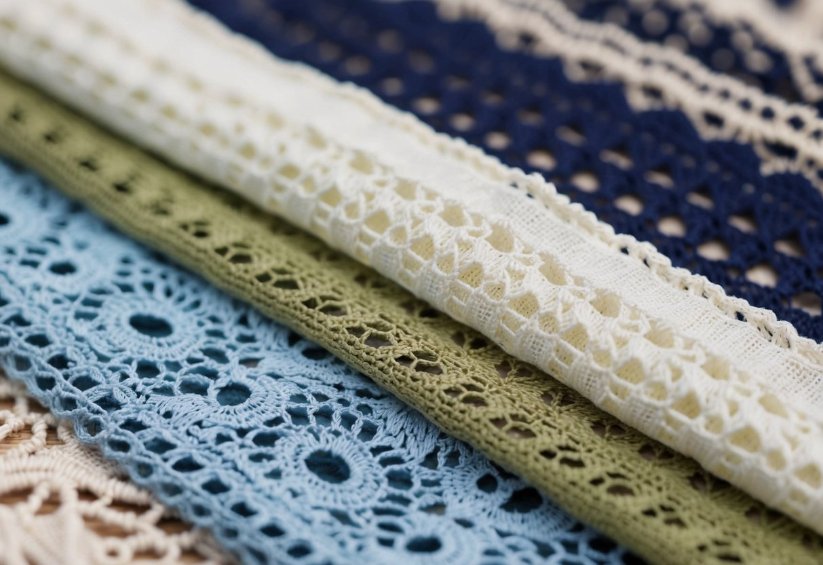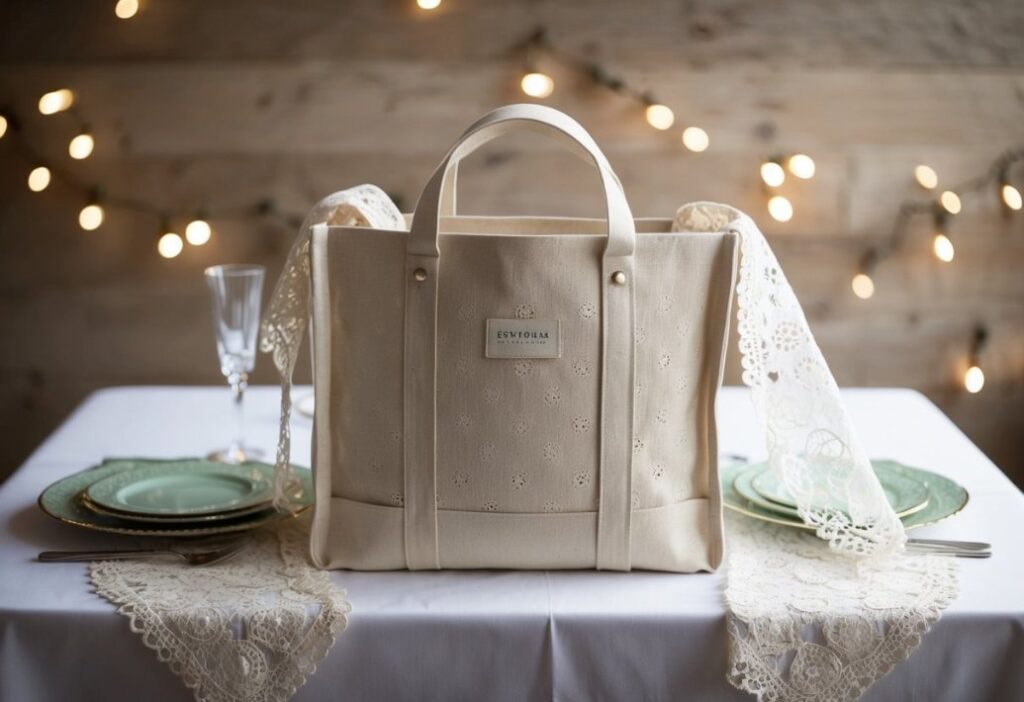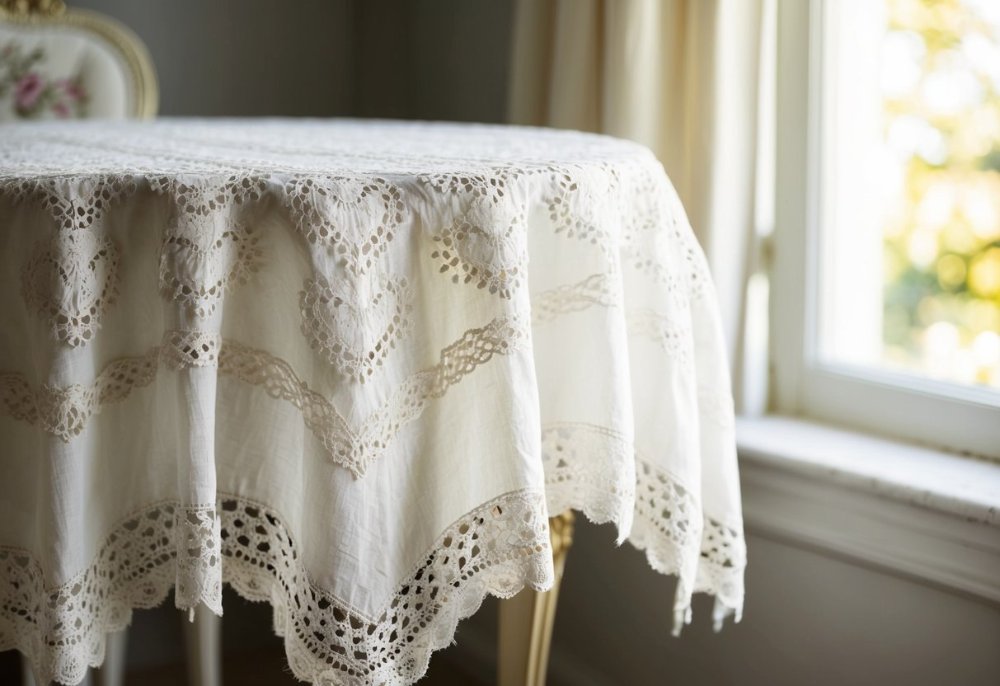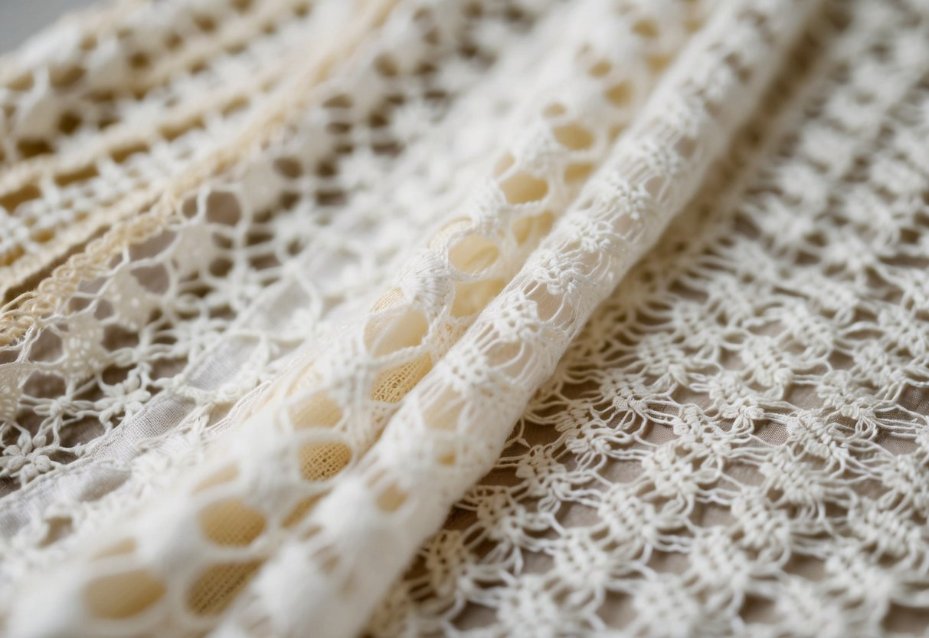Unraveling the unique crafting techniques, visual characteristics, and practical applications of these decorative textiles
Eyelet fabric and lace both create beautiful patterns with holes, yet they differ in significant ways. Eyelet fabric consists of small holes with reinforced edges and embroidered patterns, while lace is a delicate fabric built from a single thread woven into intricate designs.
Eyelet offers a more casual, bohemian look compared to traditional lace, making it perfect for summer dresses and lightweight garments. The fabric’s sturdy cotton base provides better durability than delicate lace while maintaining an airy, romantic appearance.
Many fashion designers choose eyelet as a budget-friendly alternative that captures lace’s essence without the high cost. The versatile material works brilliantly for both casual wear and special occasions, bringing texture and visual interest to any garment.
On This Page
Key Takeaways
- Eyelet fabric features reinforced holes in cotton material, while lace is woven from a single continuous thread
- Eyelet provides a more durable and affordable alternative to traditional lace
- Both materials serve decorative and functional purposes in modern fashion design
Understanding the Basics of Fabric
Textiles feature distinct construction methods and patterns that create unique characteristics and visual appeal. Both eyelet and lace showcase intricate designs through different manufacturing techniques.
Defining Eyelet
Eyelet fabric consists of detailed holes with embroidered edges throughout the material. It typically uses cotton or cotton-blend as its base.
The distinctive pattern forms through a precise manufacturing process where small, round holes are cut into the fabric. These holes receive reinforcement from tight embroidery stitches around their edges.
The decorative holes range from tiny pin-sized openings to larger circular patterns. This creates an airy, lightweight textile perfect for warm-weather garments.
Exploring Types of Lace
Traditional lace features interconnected threads woven into intricate patterns without a solid base fabric. The delicate designs create open spaces between the threads.
Common varieties include:
- Chantilly lace: Features detailed floral patterns
- Guipure lace: Has raised, bold motifs
- Valencia lace: Shows geometric designs
- Alençon lace: Displays fine needlework
While eyelet resembles lace, the key difference lies in construction. Lace forms its pattern through thread manipulation, whilst eyelet relies on cutting and embroidering a base fabric.
Distinctive Features of Eyelet Fabric and Lace

Both eyelet fabric and lace add elegant detail to textiles through decorative holes and patterns, yet they differ significantly in their construction methods and visual appeal.
Characteristics of Eyelet Fabric
Eyelet fabric features distinctive cut-out patterns surrounded by embroidered edges. The holes are precisely punched into the base fabric and reinforced with stitching to prevent fraying.
Eyelet comes in various weights and materials. Cotton and wool varieties offer different drape qualities, with knit versions providing up to 50% stretch across the grain.
The holes in eyelet fabric follow uniform patterns and sizes. These perforations create a semi-sheer effect that adds both ventilation and visual interest to the textile.
Lace Varieties and Their Attributes
Traditional lace lacks a base fabric, instead being created through intricate looping and knotting of threads. The patterns are more complex than eyelet, often featuring floral designs and scalloped edges.
Common lace types include:
- Chantilly: Fine, detailed patterns with scalloped edges
- Guipure: Heavy cotton lace with raised designs
- Valenciennes: Delicate diamond-shaped mesh background
Lace construction methods vary greatly. Some use hundreds of bobbins to create elaborate designs, whilst others employ needle techniques to form delicate meshwork patterns.
Raw Materials and Composition

The materials used in eyelet fabrics and laces vary greatly, with natural fibres like cotton and silk playing prominent roles alongside synthetic options like polyester. Each material brings unique properties that affect the final fabric’s durability, texture and appearance.
Cotton and Its Uses in Eyelet and Lace
Eyelet fabric traditionally uses cotton as its primary material, creating a breathable and comfortable base for the distinctive perforated pattern. Pure cotton eyelet offers excellent breathability and a crisp texture perfect for summer garments.
Cotton lace tends to be more delicate than eyelet and requires careful handling during manufacturing. The natural fibre creates intricate patterns that work beautifully for hems and necklines.
Cotton blend eyelets provide enhanced durability while maintaining the fabric’s characteristic appearance. These blends often incorporate:
- Polyester for strength
- Elastane for stretch
- Rayon for drape
Synthetic Fabrics: Polyester Lace
Polyester lace dominates the modern market due to its cost-effectiveness and durability. This synthetic material creates strong, long-lasting lace that resists wear and tear.
Modern manufacturing techniques allow polyester lace to mimic the delicate appearance of natural fibres. The material excels in:
- Colour retention
- Shape maintenance
- Wash resistance
Polyester lace works particularly well for structured garments and decorative necklines, maintaining its form through multiple wears.
Inclusion of Silk and Leather
Silk adds luxury to both eyelet and lace creations. Its natural sheen creates sophisticated garments suitable for formal wear. Premium silk eyelet combines the fabric’s characteristic holes with silk’s smooth texture.
Leather accents occasionally appear alongside eyelet and lace in contemporary fashion. Designers combine these materials to create textural contrast, typically using:
- Soft leather bindings
- Leather trim details
- Decorative leather appliqués
The combination of silk or leather with eyelet patterns creates unique textile compositions that serve both decorative and functional purposes.
Eyelet and Lace in Fashion Apparels

Both eyelet fabric and lace add elegance and visual interest to clothing. Eyelet fabric originated in England during the 16th century and has since become a staple in fashion design alongside traditional lace.
Integrating Eyelet and Lace in Daily Wear
Eyelet fabric offers versatility in casual clothing with its breathable, lightweight properties. Women’s blouses and summer dresses commonly feature eyelet details along hemlines and sleeves.
Cotton eyelet works particularly well for warm-weather garments, providing both style and comfort. Popular applications include:
- Sleeveless tops with eyelet trim
- A-line skirts with eyelet overlay
- Casual sundresses with eyelet panels
Formal and Bridal Wear: The Role of Lace
Wedding dresses often showcase intricate lace patterns and detailed embroidery. Traditional lace remains the preferred choice for bridal wear due to its delicate appearance and rich heritage.
Formal evening wear incorporates lace in various ways:
- Full lace overlays on gowns
- Lace sleeves and necklines
- Detailed trim work on hemlines
Eyelet Accents in Blouses and Dresses
Modern fashion combines eyelet with contemporary styles to create fresh looks. Blouses feature eyelet patterns in strategic locations for visual interest.
Common placement of eyelet details:
- Collar and yoke designs
- Sleeve cuffs
- Front plackets
Dresses utilise eyelet fabric to create texture and dimension. Design elements include eyelet panels, borders, and full eyelet construction in both fitted and loose silhouettes.
Functional Uses of Eyelets

Eyelets serve essential roles in both footwear and garment construction. These metal rings create reinforced openings that withstand repeated stress from lacing and threading whilst maintaining structural integrity.
Footwear: From Sneakers to Work Boots
Metal eyelets are crucial components in modern footwear design. Eyelets are used in clothing and shoes for both practical purposes and visual appeal.
In trainers, eyelets guide laces whilst preventing fabric tears. The positioning of these rings affects lacing tension and foot stability.
Military and work boots utilise heavy-duty brass or steel eyelets. These withstand intense daily wear and allow for quick lacing adjustments.
Hiking boots feature specialised eyelets called speed hooks at the ankle. This design lets walkers adjust boot tightness for varying terrain and comfort needs.
Punched Eyelets and Their Utilisation
The process of adding eyelets requires precise placement and proper tools. A hole punch creates the initial opening, followed by eyelet insertion and securing.
Crafting enthusiasts often use eyelet tools for DIY projects. The technique involves measuring, marking, and reinforcing the fabric before punching.
Punched eyelets must be properly sized to their intended use. Small eyelets suit light fabrics and decorative purposes, whilst larger ones handle heavy-duty applications like canvas or leather goods.
Professional-grade eyelets feature rolled edges to prevent cutting into laces or thread. This design element extends the lifespan of both the eyelet and the materials passing through it.
Eyelet Fabric and Lace as Decorative Elements

Eyelet fabric and lace serve as versatile decorative elements that add texture and visual interest to both fashion and interiors. These fabrics create an elegant, airy appearance whilst maintaining durability for practical use.
Home Decor: A Blend of Functionality and Style
Eyelet fabric and lace work brilliantly in home décor applications, from curtains to tablecloths. The fabric’s natural breathability makes it perfect for window treatments, allowing filtered light to enter whilst maintaining privacy.
Interior designers often choose white or cream eyelet fabric for a classic look, though modern homes incorporate bold colours and patterns. Popular uses include:
- Bed linens and duvet covers
- Decorative cushion covers
- Table runners and placemats
- Light fixtures and lampshades
Embellishments: Sequins, Beads and Floral Motifs
Both eyelet fabric and lace can be enhanced with additional embellishments to create stunning decorative pieces. Traditional eyelet patterns feature circular holes with embroidered edges, but modern versions incorporate varied designs.
Common embellishment techniques include:
- Hand-sewn beading along pattern edges
- Sequin clusters between eyelet designs
- Embroidered floral motifs
- Metallic thread accents
These embellishments work particularly well for special occasion items like wedding décor and holiday table settings. The combination of texture and sparkle adds dimension and visual interest to any space.
The Historical Context of Eyelet and Lace
Both eyelet fabric and lace emerged as significant textile innovations in 16th century Europe, with each developing its own distinct techniques and cultural significance.
The Victorian Influence and Modern Evolution
Eyelet fabric gained prominence in England during the 16th century. The distinctive perforated patterns became a hallmark of Victorian fashion, adorning women’s dresses, blouses, and parasols.
Venetian lace craftsmen developed intricate patterns that set the standard for European lace-making. Their techniques spread across the continent through trade routes and royal patronage.
The Victorian era marked the peak of both eyelet and lace production. Queen Victoria’s preference for white eyelet designs in her wedding dress sparked a lasting trend that influenced bridal fashion for generations.
Global Traditions and Lace Making Techniques
Different regions developed unique lace-making methods as the craft spread across Europe. French artisans created Chantilly lace, known for its delicate floral patterns on black silk.
Eyelet production evolved from hand-punched holes to machine-made designs. This technological advancement made the fabric more accessible to middle-class consumers.
Today, both traditional and modern manufacturing methods coexist. While machines produce most commercial eyelet fabric, skilled artisans still create handmade lace using centuries-old techniques.
Manufacturing Processes
The creation of eyelet fabric and lace involves distinct techniques that require different tools and expertise. Each process demands precision and skilled craftsmanship to achieve the desired decorative patterns.
How Is Eyelet Fabric Made?
Eyelet fabric production starts with a base material, typically cotton or cotton blend. Manufacturers punch holes into the fabric using specialised cutting tools.
The edges of these holes are reinforced through embroidery with thread that matches or contrasts with the base fabric. This reinforcement prevents fraying and creates the distinctive decorative pattern.
Modern manufacturing uses automated machines to create uniform holes and embroidery patterns. The machines can produce hundreds of eyelets per minute while maintaining consistent quality.
The Art of Needle Lace Construction
Needle lace requires meticulous handwork with a single thread and needle. The artisan creates intricate patterns by working from a basic outline drawn on paper or parchment.
The process begins with creating anchor points by stitching temporary support threads. The lacemaker then works in a systematic pattern, building up the design with various decorative stitches.
Each motif connects to others through delicate bridges of thread work. This time-intensive process creates unique, delicate patterns that distinguish true lace from machine-made alternatives.
Frequently Asked Questions
Eyelet fabric and lace share decorative qualities whilst maintaining distinct construction methods, care requirements, and sewing considerations. Proper understanding of these textiles helps crafters select the right material for each project.
How is broderie anglaise constructed?
Eyelet fabric originated in the Czech Republic during the Victorian era. The fabric features embroidered holes with reinforced edges sewn into a base fabric.
The holes are cut and stitched around using specialised machinery or hand embroidery techniques. Most designs incorporate floral or geometric patterns between the eyelets.
What are the key differences between broderie anglaise and lace?
Traditional lace lacks a base fabric and consists entirely of interconnected threads forming a pattern. Eyelet fabric uses a solid base material with decorative holes punched through it.
The holes in eyelet fabric appear at regular intervals, whilst lace can feature more varied and organic patterns.
What are some tips for sewing with broderie anglaise?
Use sharp needles to prevent snags and tears around the eyelets. Pre-wash the fabric to prevent shrinkage after construction.
Press the fabric on the wrong side to protect the raised embroidery patterns. Consider French seams to create neat finishes.
In what ways can eyelet fabric be utilised in dressmaking?
Eyelet fabric works beautifully for skirts, dresses, and blouses. It excels in vintage-inspired clothing and heirloom projects.
The fabric suits overlays, inserts, and trims. Light colours create lovely summer garments and christening gowns.
Can eyelet fabric be considered a type of lace, and if so, how?
Eyelet fabric shares visual elements with lace but maintains its own distinct category. The punched holes and embroidered edges create a lace-like appearance.
The fabric offers similar delicate, ornamental qualities to lace whilst providing more structure and durability.
What textiles bear a close resemblance to lace in terms of appearance and texture?
Crochet and tatting create openwork patterns similar to lace. Net and tulle fabrics offer comparable sheerness and delicacy.
Modern laser-cut fabrics can mimic traditional lace patterns. Embroidered mesh provides a contemporary alternative with similar visual appeal.

